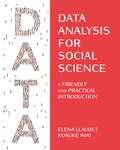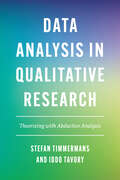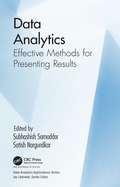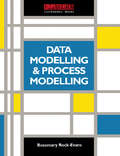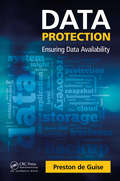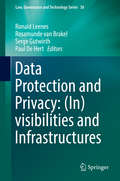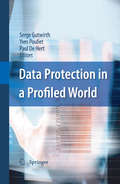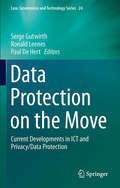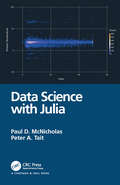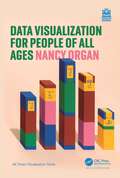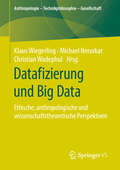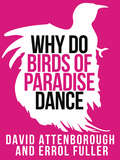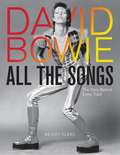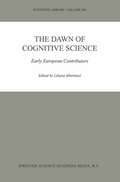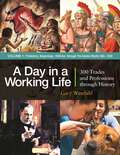- Table View
- List View
Data Analysis for Social Science: A Friendly and Practical Introduction
by Elena Llaudet Kosuke ImaiAn ideal textbook for an introductory course on quantitative methods for social scientists—assumes no prior knowledge of statistics or codingData Analysis for Social Science provides a friendly introduction to the statistical concepts and programming skills needed to conduct and evaluate social scientific studies. Using plain language and assuming no prior knowledge of statistics and coding, the book provides a step-by-step guide to analyzing real-world data with the statistical program R for the purpose of answering a wide range of substantive social science questions. It teaches not only how to perform the analyses but also how to interpret results and identify strengths and limitations. This one-of-a-kind textbook includes supplemental materials to accommodate students with minimal knowledge of math and clearly identifies sections with more advanced material so that readers can skip them if they so choose.Analyzes real-world data using the powerful, open-sourced statistical program R, which is free for everyone to useTeaches how to measure, predict, and explain quantities of interest based on dataShows how to infer population characteristics using survey research, predict outcomes using linear models, and estimate causal effects with and without randomized experimentsAssumes no prior knowledge of statistics or codingSpecifically designed to accommodate students with a variety of math backgroundsProvides cheatsheets of statistical concepts and R codeSupporting materials available online, including real-world datasets and the code to analyze them, plus—for instructor use—sample syllabi, sample lecture slides, additional datasets, and additional exercises with solutionsLooking for a more advanced introduction? Consider Quantitative Social Science by Kosuke Imai. In addition to covering the material in Data Analysis for Social Science, it teaches diffs-in-diffs models, heterogeneous effects, text analysis, and regression discontinuity designs, among other things.
Data Analysis in Qualitative Research: Theorizing with Abductive Analysis
by Stefan Timmermans Iddo TavoryFrom two experts in the field comes an accessible, how-to guide that will help researchers think more productively about the relation between theory and data at every stage of their work. In Data Analysis in Qualitative Research, Iddo Tavory and Stefan Timmermans provide a how-to guide filled with tricks of the trade for researchers who hope to take excellent qualitative data and transform it into powerful scholarship. In their previous book, Abductive Analysis: Theorizing Qualitative Research, Timmermans and Tavory offered a toolkit for innovative theorizing in the social sciences. In this companion, they go one step further to show how to uncover the surprising revelations that lie waiting in qualitative data—in sociology and beyond. In this book, they lay out a series of tools designed to help both novice and expert scholars see and understand their data in surprising ways. Timmermans and Tavory show researchers how to “stack the deck” of qualitative research in favor of locating surprising findings that may lead to theoretical breakthroughs, whether by engaging with theory, discussing research strategies, or walking the reader through the process of coding data. From beginning to end of a research project, Data Analysis in Qualitative Research helps social scientists pinpoint the most promising paths to take in their approach.
Data Analytics: Effective Methods for Presenting Results (Data Analytics Applications)
by Subhashish Samaddar Satish NargundkarIf you are a manager who receives the results of any data analyst’s work to help with your decision-making, this book is for you. Anyone playing a role in the field of analytics can benefit from this book as well. In the two decades the editors of this book spent teaching and consulting in the field of analytics, they noticed a critical shortcoming in the communication abilities of many analytics professionals. Specifically, analysts have difficulty in articulating in business terms what their analyses showed and what actionable recommendations were made. When analysts made presentations, they tended to lapse into the technicalities of mathematical procedures, rather than focusing on the strategic and tactical impact and meaning of their work. As analytics has become more mainstream and widespread in organizations, this problem has grown more acute. Data Analytics: Effective Methods for Presenting Results tackles this issue. The editors have used their experience as presenters and audience members who have become lost during presentation. Over the years, they experimented with different ways of presenting analytics work to make a more compelling case to top managers. They have discovered tried and true methods for improving presentations, which they share. The book also presents insights from other analysts and managers who share their own experiences. It is truly a collection of experiences and insight from academics and professionals involved with analytics. The book is not a primer on how to draw the most beautiful charts and graphs or about how to perform any specific kind of analysis. Rather, it shares the experiences of professionals in various industries about how they present their analytics results effectively. They tell their stories on how to win over audiences. The book spans multiple functional areas within a business, and in some cases, it discusses how to adapt presentations to the needs of audiences at different levels of management.
Data Analytics: Effective Methods for Presenting Results (Data Analytics Applications)
by Subhashish Samaddar Satish NargundkarIf you are a manager who receives the results of any data analyst’s work to help with your decision-making, this book is for you. Anyone playing a role in the field of analytics can benefit from this book as well. In the two decades the editors of this book spent teaching and consulting in the field of analytics, they noticed a critical shortcoming in the communication abilities of many analytics professionals. Specifically, analysts have difficulty in articulating in business terms what their analyses showed and what actionable recommendations were made. When analysts made presentations, they tended to lapse into the technicalities of mathematical procedures, rather than focusing on the strategic and tactical impact and meaning of their work. As analytics has become more mainstream and widespread in organizations, this problem has grown more acute. Data Analytics: Effective Methods for Presenting Results tackles this issue. The editors have used their experience as presenters and audience members who have become lost during presentation. Over the years, they experimented with different ways of presenting analytics work to make a more compelling case to top managers. They have discovered tried and true methods for improving presentations, which they share. The book also presents insights from other analysts and managers who share their own experiences. It is truly a collection of experiences and insight from academics and professionals involved with analytics. The book is not a primer on how to draw the most beautiful charts and graphs or about how to perform any specific kind of analysis. Rather, it shares the experiences of professionals in various industries about how they present their analytics results effectively. They tell their stories on how to win over audiences. The book spans multiple functional areas within a business, and in some cases, it discusses how to adapt presentations to the needs of audiences at different levels of management.
Data Modelling and Process Modelling using the most popular Methods: Covering SSADM, Yourdon, Inforem, Bachman, Information Engineering and 'Activity/Object' Diagramming Techniques
by Rosemary Rock-EvansComputer Weekly Professional Series: Data modeling and Process modeling: Using the Most Popular Methods focuses on the processes, methodologies, and approaches employed in data modeling and process modeling. The book first offers information on data modeling, how to do data modeling, and process modeling. Discussions focus on diagrammatic representation, main concepts of process modeling, merging the models, refining the data model, diagrammatic techniques, fundamental rules of data modeling, and other deliverables of data modeling. The text then examines how to do process modeling and improving a system using analysis deliverables. Topics include problems, causes and effects, events, obligations and objectives, verification methods, and refining the results. The manuscript reviews elementary activities, including structured text and access paths, updating the data model from the access paths and structured English, and other useful detailed deliverables of an elementary activity.The publication is a valuable source of data for researchers interested in data modeling and process modeling.
Data Protection: Ensuring Data Availability
by Preston de GuiseThis is the fundamental truth about data protection: backup is dead. Or rather, backup and recovery, as a standalone topic, no longer has relevance in IT. As a standalone topic, it’s been killed off by seemingly exponential growth in storage and data, by the cloud, and by virtualization. So what is data protection? This book takes a holistic, business-based approach to data protection. It explains how data protection is a mix of proactive and reactive planning, technology and activities that allow for data continuity. It shows how truly effective data protection comes from a holistic approach considering the entire data lifecycle and all required SLAs. Data protection is neither RAID nor is it continuous availability, replication, snapshots or backups—it is all of them, combined in a considered and measured approach to suit the criticality of the data and meet all the requirements of the business. The book also discusses how businesses seeking to creatively leverage their IT investments and to drive through cost optimization are increasingly looking at data protection as a mechanism to achieve those goals. In addition to being a type of insurance policy, data protection is becoming an enabler for new processes around data movement and data processing. This book arms readers with information critical for making decisions on how data can be protected against loss in the cloud, on-premises, or in a mix of the two. It explains the changing face of recovery in a highly virtualized data center and techniques for dealing with big data. Moreover, it presents a model for where data recovery processes can be integrated with IT governance and management in order to achieve the right focus on recoverability across the business.
Data Protection: Ensuring Data Availability
by Preston de GuiseThis is the fundamental truth about data protection: backup is dead. Or rather, backup and recovery, as a standalone topic, no longer has relevance in IT. As a standalone topic, it’s been killed off by seemingly exponential growth in storage and data, by the cloud, and by virtualization. So what is data protection? This book takes a holistic, business-based approach to data protection. It explains how data protection is a mix of proactive and reactive planning, technology and activities that allow for data continuity. It shows how truly effective data protection comes from a holistic approach considering the entire data lifecycle and all required SLAs. Data protection is neither RAID nor is it continuous availability, replication, snapshots or backups—it is all of them, combined in a considered and measured approach to suit the criticality of the data and meet all the requirements of the business. The book also discusses how businesses seeking to creatively leverage their IT investments and to drive through cost optimization are increasingly looking at data protection as a mechanism to achieve those goals. In addition to being a type of insurance policy, data protection is becoming an enabler for new processes around data movement and data processing. This book arms readers with information critical for making decisions on how data can be protected against loss in the cloud, on-premises, or in a mix of the two. It explains the changing face of recovery in a highly virtualized data center and techniques for dealing with big data. Moreover, it presents a model for where data recovery processes can be integrated with IT governance and management in order to achieve the right focus on recoverability across the business.
Data Protection and Privacy: (Law, Governance and Technology Series #36)
by Ronald Leenes Rosamunde Van Brakel Serge Gutwirth Paul De HertThis book features peer reviewed contributions from across the disciplines on themes relating to protection of data and to privacy protection. The authors explore fundamental and legal questions, investigate case studies and consider concepts and tools such as privacy by design, the risks of surveillance and fostering trust. Readers may trace both technological and legal evolution as chapters examine current developments in ICT such as cloud computing and the Internet of Things. Written during the process of the fundamental revision of revision of EU data protection law (the 1995 Data Protection Directive), this volume is highly topical. Since the European Parliament has adopted the General Data Protection Regulation (Regulation 2016/679), which will apply from 25 May 2018, there are many details to be sorted out. This volume identifies and exemplifies key, contemporary issues. From fundamental rights and offline alternatives, through transparency requirements to health data breaches, the reader is provided with a rich and detailed picture, including some daring approaches to privacy and data protection. The book will inform and inspire all stakeholders. Researchers with an interest in the philosophy of law and philosophy of technology, in computers and society, and in European and International law will all find something of value in this stimulating and engaging work.
Data Protection in a Profiled World
by Serge Gutwirth Yves Poullet Paul De HertOne of the most challenging issues facing our current information society is the accelerating accumulation of data trails in transactional and communication systems, which may be used not only to profile the behaviour of individuals for commercial, marketing and law enforcement purposes, but also to locate and follow things and actions. Data mining, convergence, interoperability, ever- increasing computer capacities and the extreme miniaturisation of the hardware are all elements which contribute to a major contemporary challenge: the profiled world. This interdisciplinary volume offers twenty contributions that delve deeper into some of the complex but urgent questions that this profiled world addresses to data protection and privacy. The chapters of this volume were all presented at the second Conference on Privacy and Data Protection (CPDP2009) held in Brussels in January 2009 (www.cpdpconferences.org). The yearly CPDP conferences aim to become Europe’s most important meeting where academics, practitioners, policy-makers and activists come together to exchange ideas and discuss emerging issues in information technology, privacy and data protection and law. This volume reflects the richness of the conference, containing chapters by leading lawyers, policymakers, computer, technology assessment and social scientists. The chapters cover generic themes such as the evolution of a new generation of data protection laws and the constitutionalisation of data protection and more specific issues like security breaches, unsolicited adjustments, social networks, surveillance and electronic voting. This book not only offers a very close and timely look on the state of data protection and privacy in our profiled world, but it also explores and invents ways to make sure this world remains a world we want to live in.
Data Protection on the Move: Current Developments in ICT and Privacy/Data Protection (Law, Governance and Technology Series #24)
by Serge Gutwirth Ronald Leenes Paul HertThis volume brings together papers that offer methodologies, conceptual analyses, highlight issues, propose solutions, and discuss practices regarding privacy and data protection. It is one of the results of the eight annual International Conference on Computers, Privacy, and Data Protection, CPDP 2015, held in Brussels in January 2015.The book explores core concepts, rights and values in (upcoming) data protection regulation and their (in)adequacy in view of developments such as Big and Open Data, including the right to be forgotten, metadata, and anonymity. It discusses privacy promoting methods and tools such as a formal systems modeling methodology, privacy by design in various forms (robotics, anonymous payment), the opportunities and burdens of privacy self management, the differentiating role privacy can play in innovation.The book also discusses EU policies with respect to Big and Open Data and provides advice to policy makers regarding these topics.Also attention is being paid to regulation and its effects, for instance in case of the so-called ‘EU-cookie law’ and groundbreaking cases, such as Europe v. Facebook.This interdisciplinary book was written during what may turn out to be the final stages of the process of the fundamental revision of the current EU data protection law by the Data Protection Package proposed by the European Commission. It discusses open issues and daring and prospective approaches. It will serve as an insightful resource for readers with an interest in privacy and data protection.
Data Science with Julia
by Paul D. McNicholas Peter Tait"This book is a great way to both start learning data science through the promising Julia language and to become an efficient data scientist."- Professor Charles Bouveyron, INRIA Chair in Data Science, Université Côte d’Azur, Nice, France Julia, an open-source programming language, was created to be as easy to use as languages such as R and Python while also as fast as C and Fortran. An accessible, intuitive, and highly efficient base language with speed that exceeds R and Python, makes Julia a formidable language for data science. Using well known data science methods that will motivate the reader, Data Science with Julia will get readers up to speed on key features of the Julia language and illustrate its facilities for data science and machine learning work. Features: Covers the core components of Julia as well as packages relevant to the input, manipulation and representation of data. Discusses several important topics in data science including supervised and unsupervised learning. Reviews data visualization using the Gadfly package, which was designed to emulate the very popular ggplot2 package in R. Readers will learn how to make many common plots and how to visualize model results. Presents how to optimize Julia code for performance. Will be an ideal source for people who already know R and want to learn how to use Julia (though no previous knowledge of R or any other programming language is required). The advantages of Julia for data science cannot be understated. Besides speed and ease of use, there are already over 1,900 packages available and Julia can interface (either directly or through packages) with libraries written in R, Python, Matlab, C, C++ or Fortran. The book is for senior undergraduates, beginning graduate students, or practicing data scientists who want to learn how to use Julia for data science. "This book is a great way to both start learning data science through the promising Julia language and to become an efficient data scientist." Professor Charles BouveyronINRIA Chair in Data ScienceUniversité Côte d’Azur, Nice, France
Data Science with Julia
by Paul D. McNicholas Peter Tait"This book is a great way to both start learning data science through the promising Julia language and to become an efficient data scientist."- Professor Charles Bouveyron, INRIA Chair in Data Science, Université Côte d’Azur, Nice, France Julia, an open-source programming language, was created to be as easy to use as languages such as R and Python while also as fast as C and Fortran. An accessible, intuitive, and highly efficient base language with speed that exceeds R and Python, makes Julia a formidable language for data science. Using well known data science methods that will motivate the reader, Data Science with Julia will get readers up to speed on key features of the Julia language and illustrate its facilities for data science and machine learning work. Features: Covers the core components of Julia as well as packages relevant to the input, manipulation and representation of data. Discusses several important topics in data science including supervised and unsupervised learning. Reviews data visualization using the Gadfly package, which was designed to emulate the very popular ggplot2 package in R. Readers will learn how to make many common plots and how to visualize model results. Presents how to optimize Julia code for performance. Will be an ideal source for people who already know R and want to learn how to use Julia (though no previous knowledge of R or any other programming language is required). The advantages of Julia for data science cannot be understated. Besides speed and ease of use, there are already over 1,900 packages available and Julia can interface (either directly or through packages) with libraries written in R, Python, Matlab, C, C++ or Fortran. The book is for senior undergraduates, beginning graduate students, or practicing data scientists who want to learn how to use Julia for data science. "This book is a great way to both start learning data science through the promising Julia language and to become an efficient data scientist." Professor Charles BouveyronINRIA Chair in Data ScienceUniversité Côte d’Azur, Nice, France
Data Visualization for People of All Ages (ISSN)
by Nancy OrganData visualization is the art and science of making information visible. On paper and in our imaginations, it’s a language of shapes and colors that holds our best ideas and most important questions. As we find ourselves swimming in data of all kinds, visualization can help us to understand, express, and explore the richness of the world around us. No matter your age or background, this book opens the door to new ways of thinking and sharing through the power of data visualization.Data Visualization for People of All Ages is a field guide to visual literacy, born from the author’s personal experience working with world-class scholars, engineers, and scientists. By walking through the different ways of showing data—including color, angle, position, and length—you’ll learn how charts and graphs truly work so that no visualization is ever a mystery or out of reach. It doesn’t stop at what fits on a page, either. You’ll journey into cutting-edge topics like data sonification and data physicalization, using sound and touch to share data across the different senses. Packed with practical examples and exercises to help you connect the dots, this book will teach you how to create and understand data visualizations on your own—all without writing a single line of code or getting tangled up in software.Written with accessibility in mind, this book invites everyone to the table to share the joy of one of today’s most necessary skills. Perfect for home or classroom use, this friendly companion gives people of all ages everything they need to start visualizing with confidence.
Data Visualization for People of All Ages (ISSN)
by Nancy OrganData visualization is the art and science of making information visible. On paper and in our imaginations, it’s a language of shapes and colors that holds our best ideas and most important questions. As we find ourselves swimming in data of all kinds, visualization can help us to understand, express, and explore the richness of the world around us. No matter your age or background, this book opens the door to new ways of thinking and sharing through the power of data visualization.Data Visualization for People of All Ages is a field guide to visual literacy, born from the author’s personal experience working with world-class scholars, engineers, and scientists. By walking through the different ways of showing data—including color, angle, position, and length—you’ll learn how charts and graphs truly work so that no visualization is ever a mystery or out of reach. It doesn’t stop at what fits on a page, either. You’ll journey into cutting-edge topics like data sonification and data physicalization, using sound and touch to share data across the different senses. Packed with practical examples and exercises to help you connect the dots, this book will teach you how to create and understand data visualizations on your own—all without writing a single line of code or getting tangled up in software.Written with accessibility in mind, this book invites everyone to the table to share the joy of one of today’s most necessary skills. Perfect for home or classroom use, this friendly companion gives people of all ages everything they need to start visualizing with confidence.
Datafizierung und Big Data: Ethische, anthropologische und wissenschaftstheoretische Perspektiven (Anthropologie – Technikphilosophie – Gesellschaft)
by Klaus Wiegerling Michael Nerurkar Christian WadephulDer Band versammelt Beiträge, die sich mit ethischen, anthropologischen und wissenschaftstheoretischen Aspekten informationstechnologischer Anwendungen, insbesondere Big Data, befassen. In unterschiedlichen disziplinären Perspektiven werden die Auswirkungen dieser Technologien auf Individuum, Gesellschaft und Wissenschaft in den Blick genommen.
David Attenborough’s Why Do Birds of Paradise Dance (Collins Shorts #7)
by Sir David Attenborough FullerCollins Shorts – insight in an instant.
David Bowie All the Songs: The Story Behind Every Track (All the Songs)
by Benoît ClercAlbum by album and track by track, this first-of-its-kind catalog of David Bowie's entire 50-year and 27-album career tells the story of one of rock's all-time greatest artists.A lovingly thorough dissection of every album and every track ever released by David Bowie over the span of his nearly 50 year career, David Bowie All the Songs follows the musician from his self-titled debut album released in 1967 all the way through Blackstar, his final album.Delving deep into Bowie's past and featuring new commentary and archival interviews with a wide range of models, actors, musicians, producers, and recording executives who all worked with and knew the so-called "Thin White Duke", David Bowie All the Songs charts the musician's course from a young upstart in 1960s London to a musical behemoth who collaborated with everyone from Queen Latifah and Bing Crosby, to Mick Jagger and Arcade Fire.This one-of-a-kind book draws upon years of research in order to recount how each song was written, composed, and recorded, down to the instruments used and the people who played them. Featuring hundreds of vivid photographs that celebrate one of music's most visually arresting performers, David Bowie All the Songs is a must-have book for any true fan of classic rock.
David Bowie Rainbowman: 1967-1980
by Jérôme Soligny'This is a book unlike any other, the definitive analysis of David's music, told in a quiet natural way, but with absolute authenticity, by the people around him.' - HERMIONE FARTHINGALE'Jérôme Soligny is one of the best authorities in the world on David Bowie's career and life in general... His new biography Rainbowman is a thorough and honest account of the great man.' - TONY VISCONTI'Jérôme is a guy who is still aware that popular music is an art form and not a money suppository. He writes from the heart and is one of the last exemplars of a dying breed. The critic, armed with intelligence and brute compulsive honesty, as dangerous as a river.' - IGGY POP'Not long ago, Jérôme told me something that I find very true: "David played saxophone, guitar, a bit of keyboards, but above all, he played musicians!" I think he really hit the nail on the head.' - MIKE GARSONIn David Bowie Rainbowman, Jérôme Soligny tells the story of David Bowie the musician with the help of those intimately involved with the creation of his music.This uniquely exhaustive work on Bowie's 1967-1980 albums draws on over 150 interviews with the musicians, producers and friends who knew Bowie best, including Robert Fripp, Hermione Farthingale, Lou Reed, George Underwood, Mick Ronson, Carlos Alomar, Trevor Bolder, Mike Garson, Woody Woodmansey and many, many others. With an essay by Soligny on each album followed by oral histories from the most trusted and influential figures in Bowie's musical life, David Bowie Rainbowman is the definitive guide to a singular and mercurial genius - the Rainbowman himself.· With a foreword by Tony Visconti, an introduction by Mike Garson and cover photo by Mick Rock· A beautiful and stylish gift for Bowie fans, over 700 pages long, filled with iconic photographs and with striking cover design by Barnbrook
David Jones on Religion, Politics, and Culture: Unpublished Prose (Modernist Archives)
by David Jones Dr Thomas Berenato Dr Anne Price-Owen Kathleen Henderson StaudtDavid Jones – author of In Parenthesis, the great poem of World War I – is increasingly recognized as a major voice in the first generation of British modernist writers. Acclaimed by the likes of T.S. Eliot, W.B. Yeats, and W.H. Auden, his writing was deeply informed by his Catholic faith and Welsh blood. This book makes available for the first time a number of previously unpublished statements by Jones that open new perspectives on his own work and the religious, political, and cultural engagements of British modernism more broadly. Annotated throughout, with detailed commentaries exploring the historical context of each document, the volume presents the restored text of Jones's essay on Hitler and includes a letter to Neville Chamberlain, an unfinished essay on Gerard Manley Hopkins, and the transcript of an interview with Jones a year before his death. These reveal an unknown side of Jones and give fresh insight into the influences and assumptions of 20th-century British literary culture.
David Jones on Religion, Politics, and Culture: Unpublished Prose (Modernist Archives)
by David Jones Thomas Berenato Anne Price-Owen Kathleen Henderson StaudtDavid Jones – author of In Parenthesis, the great poem of World War I – is increasingly recognized as a major voice in the first generation of British modernist writers. Acclaimed by the likes of T.S. Eliot, W.B. Yeats, and W.H. Auden, his writing was deeply informed by his Catholic faith and Welsh blood. This book makes available for the first time a number of previously unpublished statements by Jones that open new perspectives on his own work and the religious, political, and cultural engagements of British modernism more broadly. Annotated throughout, with detailed commentaries exploring the historical context of each document, the volume presents the restored text of Jones's essay on Hitler and includes a letter to Neville Chamberlain, an unfinished essay on Gerard Manley Hopkins, and the transcript of an interview with Jones a year before his death. These reveal an unknown side of Jones and give fresh insight into the influences and assumptions of 20th-century British literary culture.
David Lynch
by Michel ChionMichel Chion's study of the film and television work of David Lynch has become, since its first English publication in 1995, the definitive book on one of America's finest contemporary directors. In this new edition Chion brings the book up-to-date to take into account Lynch's work in the past ten years, including the major features 'Lost Highway, The Straight Story,' and 'Mulholland Drive. 'Newly redesigned and re-illustrated, 'David Lynch 'is an indispensable companion.
David Lynch
by Michel ChionMichel Chion's study of the film and television work of David Lynch has become, since its first English publication in 1995, the definitive book on one of America's finest contemporary directors. In this new edition Chion brings the book up-to-date to take into account Lynch's work in the past ten years, including the major features 'Lost Highway, The Straight Story,' and 'Mulholland Drive. 'Newly redesigned and re-illustrated, 'David Lynch 'is an indispensable companion.
The Dawn of Cognitive Science: Early European Contributors (Synthese Library #295)
by LilianaAlbertazziCurrent debate in cognitive science, from robotics to analysis of vision, deals with problems like the perception of form, the structure and formation of mental images and their modelling, the ecological development of artificial intelligence, and cognitive analysis of natural language. It focuses in particular on the presence of a hierarchy of intellectual constructions in different formats of representation. These diverse approaches, which share a common assumption of the inner nature of representation, call for a new epistemology - even a new psychophysics - based on a theory of reference which is intrinsically cognitive. As a contribution to contemporary research, the reading presents the core of theories developed in Central Europe between the late nineteenth and early twentieth centuries by philosophers, physicists, psychologists and semanticists who shared a dynamic approach and a pronounced concern with problems of interaction and dependence. These theories offer innovative solutions to some of the epistemological and philosophical problems currently at the centre of debate, like part-whole, theory of relations, and conceptual and linguistic categorization.
A Day in a Working Life [3 volumes]: 300 Trades and Professions through History [3 volumes]
by Gary WestfahlIdeal for high school and college students studying history through the everyday lives of men and women, this book offers intriguing information about the jobs that people have held, from ancient times to the 21st century.This unique book provides detailed studies of more than 300 occupations as they were practiced in 21 historical time periods, ranging from prehistory to the present day. Each profession is examined in a compelling essay that is specifically written to inform readers about career choices in different times and cultures, and is accompanied by a bibliography of additional sources of information, sidebars that relate historical issues to present-day concerns, as well as related historical documents.Readers of this work will learn what each profession entailed or entails on a daily basis, how one gained entry to the vocation, training methods, and typical compensation levels for the job. The book provides sufficient specific detail to convey a comprehensive understanding of the experiences, benefits, and downsides of a given profession. Selected accompanying documents further bring history to life by offering honest testimonies from people who actually worked in these occupations or interacted with those in that field.
A Day in a Working Life [3 volumes]: 300 Trades and Professions through History [3 volumes]
by Gary WestfahlIdeal for high school and college students studying history through the everyday lives of men and women, this book offers intriguing information about the jobs that people have held, from ancient times to the 21st century.This unique book provides detailed studies of more than 300 occupations as they were practiced in 21 historical time periods, ranging from prehistory to the present day. Each profession is examined in a compelling essay that is specifically written to inform readers about career choices in different times and cultures, and is accompanied by a bibliography of additional sources of information, sidebars that relate historical issues to present-day concerns, as well as related historical documents.Readers of this work will learn what each profession entailed or entails on a daily basis, how one gained entry to the vocation, training methods, and typical compensation levels for the job. The book provides sufficient specific detail to convey a comprehensive understanding of the experiences, benefits, and downsides of a given profession. Selected accompanying documents further bring history to life by offering honest testimonies from people who actually worked in these occupations or interacted with those in that field.
